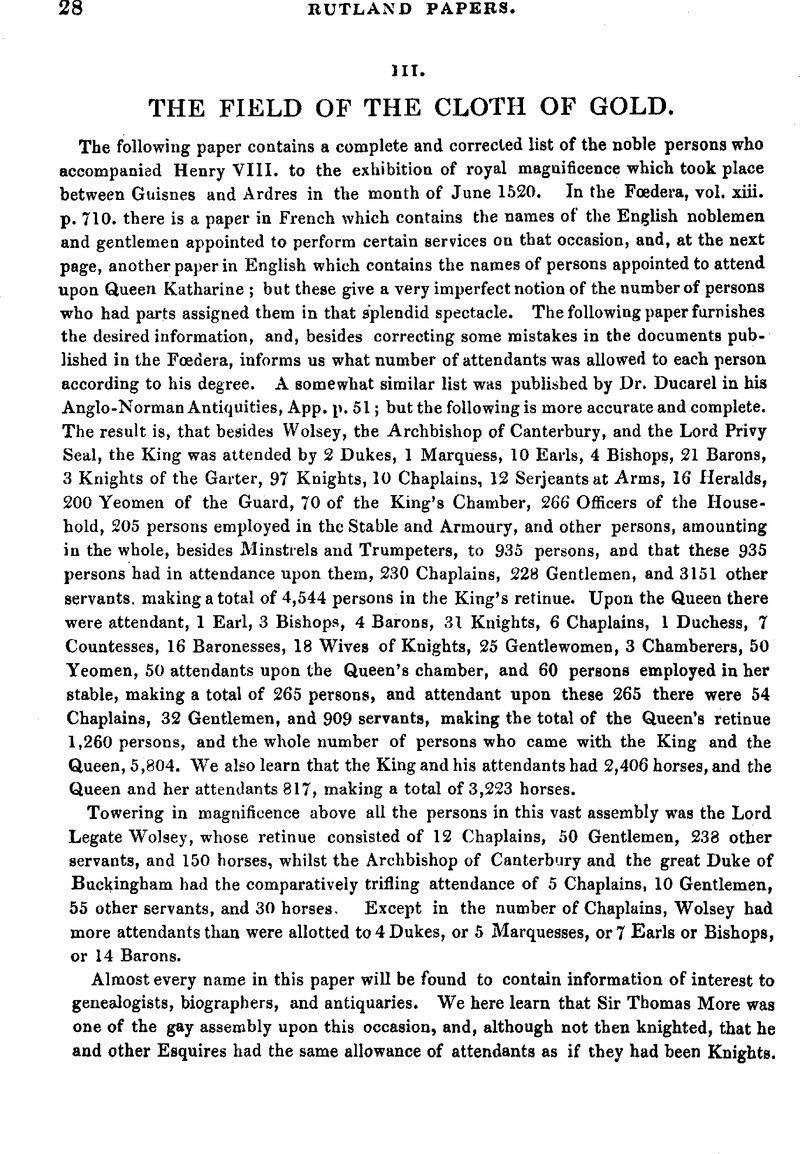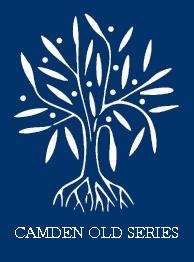No CrossRef data available.
Article contents
III. The Field of the Cloth of Gold
Published online by Cambridge University Press: 23 February 2010
Abstract

- Type
- Rutland Papers
- Information
- Copyright
- Copyright © Royal Historical Society 1842
References
page 29 note a The words within brackets have been added, the original being without a title.
page 30 note a It was probably through the nobleman here mentioned that this paper came into the possession of its present noble owner. George Manners, the descendant of a very ancient and important family in Northumberland, acquired the Barony of Roos as the heir of his mother Alianore, sister and coheir of Edmund Lord Roos. He married Anne, daughter and heir to Sir Thomas St. Leger, Knight, and Anne Duchess of Exeter his wife, sister to King Edward IV. and by her had a son Thomas, who was Lord Roos at the time of the Field of the Cloth of Gold, but on the 28th June, 1525, was advanced to the Earldom of Rutland. (Dug. Bar. ii. 296.)
page 31 note a Originally written “Edward.”
page 32 note a “Sir Miles Bushey” was originally inserted after Sir Thomas Newport, but afterwards erased, and “with the Quene” written against his name. He will be found mentioned amongst the Queen's attendants, at p. 36.
page 32 note b A blank in the original.
page 32 note c “Sir Richard Carver” was originally inserted between Skevington and Bray, but afterwards erased.
page 33 note a It does not seem to have been noticed, by any of the numerous biographers of Sir Thomas More, that he was present at the Cloth of Gold.
page 33 note b Between Carewe and Gascoyn “John Mordaunt” was originally inserted, but afterwards struck out.
page 33 note c “Gerard Danet” was inserted after Fulgeham, but afterwards struck out, and “ded” written against his name.
page 33 note d Originally written “Robert.”
page 33 note e That is, all the Knights and Esquires above enumerated.
page 33 note f Sir Henry Wyatt, father of Wyatt the poet, was Knight Marshal. Manning and Bray's Surrey, iii. App. xxvi.
page 34 note a The number is not inserted in the MS.
page 36 note a “Sir George Selynger” was originally inserted next to Sir John Hampden, but afterwards blotted out.
page 36 note b “Sir Henry Sacheverel” originally followed Mordan, but was afterwards omitted.
page 36 note c A blank in the original. “Sir William Rede” was originally inserted between verney and Parys, but was afterwards struck out.
page 39 note a The Marechal de Fleuranges, a French historian of the interview, speaks of Henry's palace in terms little less glowing than those of the recorder of London, although his description is not quite so minute. He says, “la dicte maison … etoit de merveilleuse grandeur en carrure; et estoit la dicte maison toute de bois, de toille, et de verre, et estoit la plus belle verrine que jamais l'on vist, car la moitié de la maison estoit toute de verrine et vous asseure qu'il y faisoit bien clair; et y avoit quatre corps de maison dont au moindre vous eussiez logé un Prince; …. et la chapelle de merveilleuse grandeur, et bien estoffée tant de reliques que de toutes autres paremens; et vous asseure que si tout cela estoit bien fourni, aussi estoient les caves, car les maisons des deux Princes durant le voyage ne furent fermées à personne.” Mem. de Fleuranges, 319, 320.
page 41 note a This amount is printed as it stands in the MS.
page 41 note b beyng in MS.
page 42 note a This amount is printed as it stands in the MS.
page 45 note a See note, p. 30.
page 45 note b The paper is torn here.
page 46 note a The paper is here torn away.
page 46 note b Fleuranges says, that Henry was “ung merveilleusement bon archer, et fort, et le faisoit bon veoir.” Memoires, p. 329.
page 49 note a Mem. de Bellai, i. 118.


